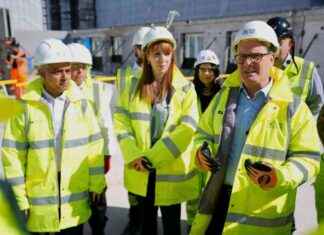The aircraft’s use and missions derive its characteristics. First challenge for the Rafale Marine, take off from a bridge 200 meters long, like that of the aircraft carrier Charles de Gaulle, instead of a concrete runway generally to NATO standard 2,400 meters in length frequented by the Rafales of the Air Force. To make it “twelve times shorter”, the Rafale Marine is assisted by a catapult using steam from the aircraft carrier’s nuclear boiler. The weight of the aircraft is around 20 tons. The acceleration of the catapult in 75 meters reaches 5 g, from 0 to 240 km/h in three seconds. These are then considerable efforts, nearly 100 tons, which are exerted on the front axle. First compressed, it then relaxes by bringing the aircraft towards its flight attitude. The pilot applied full throttle with the afterburner. This reheat injects fuel behind the turbine and causes additional thrust. The Rafale then consumes 600 kilos of fuel per minute. Concorde was the only civilian aircraft to use this same device.
Initially, it will not be the take-off technique used by the Indian Navy’s 26 Rafale Marines. It has two aircraft carriers Stobar (acronym for Short Take-Off But Arrested Recovery) which combine a runway of about 150 meters with a springboard and another equipped with arresting lines for landing. But India plans to eventually equip itself with a Catobar aircraft carrier (acronym for Catapult Assisted Take-Off But – or Barrier – Arrested Recovery) with the same configuration as Charles de Gaulle or American aircraft carriers.
Both legs of the main gear are particularly stressed during the landing, often referred to as a “controlled crash”. We are far from the “kiss landing” that a Rafale Air can afford when landing on the long runway of an airbase. In naval mode, it is a question of pressing the plane on the deck, without the classic rounding, and of hooking one of the strands of stop to brake. The outcome is so uncertain that the pilot goes over the gas and maintains them until he notices that a stop rope has been entered. The efforts are commensurate when 15 tons come into contact with the bridge at more than 250 km / h. To accommodate this more muscular landing gear, the hatches have been adapted as well as the kinematics.
These structural reinforcements result in approximately 300 kilos more on the mass estimate compared to the Rafale Air C single-seater (9,350 kilos). This corresponds to as much less fuel (therefore autonomy) or more restrictive choices for armament. Note that this is calculated so that the remaining loads after the mission are symmetrical, a landing with an aircraft having a container under one wing and nothing under the other being excluded. Note also the presence of a quick emptying system allowing part of the fuel to be drained to respect the maximum weight on landing.
A stick, extended during the approach, retractable in flight, was added to stop the aircraft for about 70 meters thanks to the arresting lines. On the nose gear leg, three lights (green, amber and red) indicate to the landing officer the aircraft’s angle of attack, on which the outcome of the touchdown depends.
The Rafale Marine version incorporates a telescopic ladder for access to the cockpit, which avoids cluttering the always constrained deck of an aircraft carrier with stepladders. Overall, 80% of the same components are found on the Air and Marine versions of the Rafale, which is also an advantage for India, which already has 36 Rafale Air ordered in 2016. The customer benefits from the digital generation developments launched by Dassault Aviation, such as assisted maintenance, aircraft inspection by drone, etc. All digital.
Less visible, other equipment is modified or added to the naval version. Thus, the ejection seat, effective even on the ground, is adjusted so that the ejection takes place slightly to the left so as not to hit the island of the aircraft carrier located to starboard. A windshield washer is installed at the base of the windshield to remove salt and scum that settles. An obsession of mechanics on previous generations of on-board aircraft, corrosion is no longer a major concern on the Rafale, whose wings are made of composite.
After an international competition aimed at procuring combat aircraft that could be embarked on the two aircraft carriers, India therefore selected the Rafale Marine, the first examples of which had been put into service with the Charles de Gaulle in 2001. The Dassault Aviation aircraft, which has since undergone various evolutions and continues to integrate new systems, won over its American rival, the Boeing F/A-18 Super Hornet. The two aircraft manufacturers were finalists in a process that formally began in 2017.
When will India deliver Rafale M.? “The first aircraft is scheduled 38 months after the signing of the financial amendment and then one aircraft is delivered per month, which leads to the end of 2027,” said Éric Trappier, CEO of Dassault Aviation, Thursday July 20 during the presentation of the half-year accounts. Neither the aircraft manufacturer nor the Indian Navy quotes a price for the Rafale Marine. However, comparisons can be made with the unit production cost amounts given in 2014 to parliamentarians for the Rafale in France. Two-seater Rafale B: 73 million euros. Single-seater Rafale C: 68 million euros. Rafale M.: 78 million euros. The Marine version would therefore cost 5 million euros more. But the figures, after negotiations, may be different…
Can Dassault Aviation hope to sell more Rafale Navy versions? The countries that have aircraft carriers, in addition to France and the United States, are therefore India, Russia, Spain, China, the United Kingdom, Brazil and Italy. These countries which have models of conventional aircraft carriers of different sizes and capacities do not seem to be potential customers already equipped with Russian (Mig 29) or American (F-35) aircraft.






